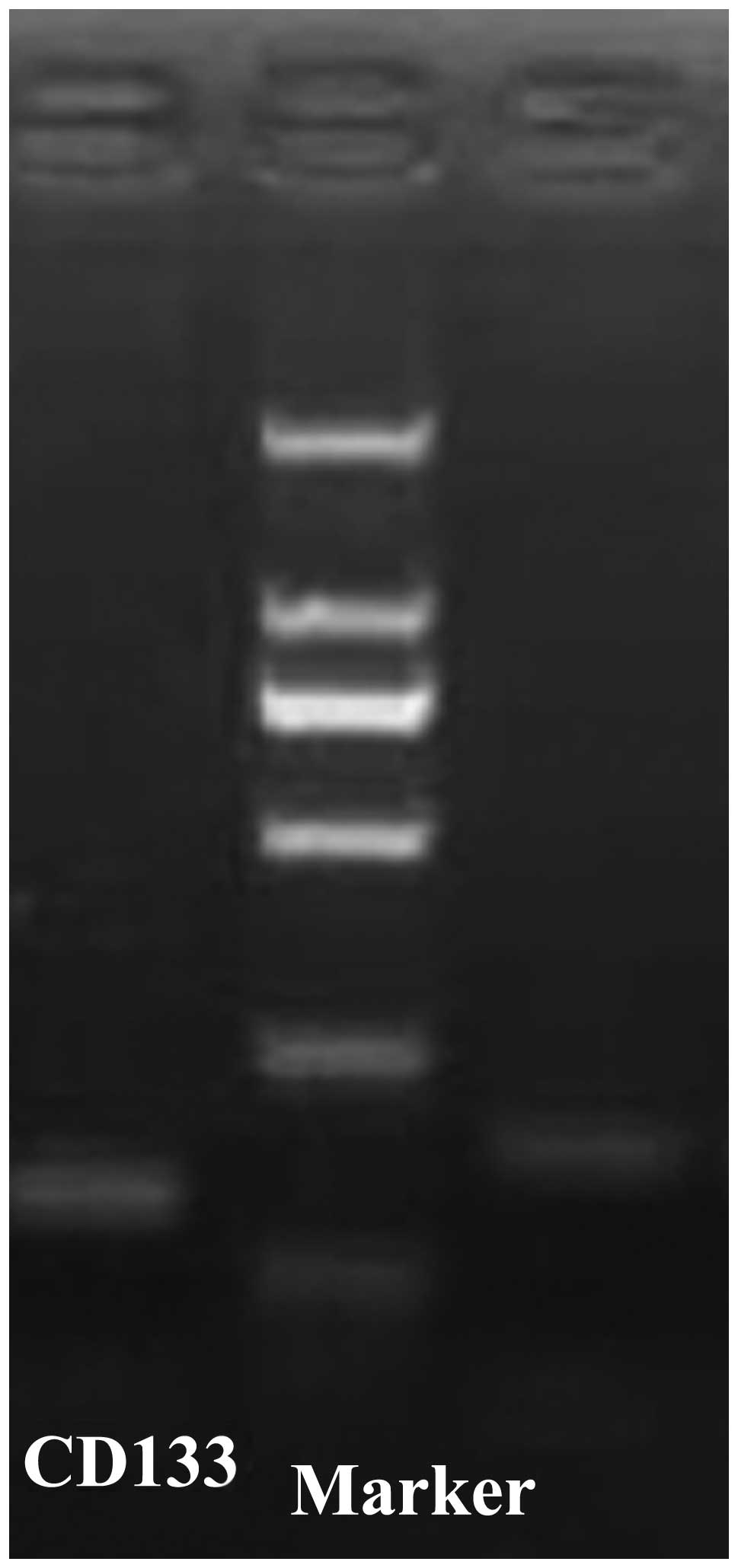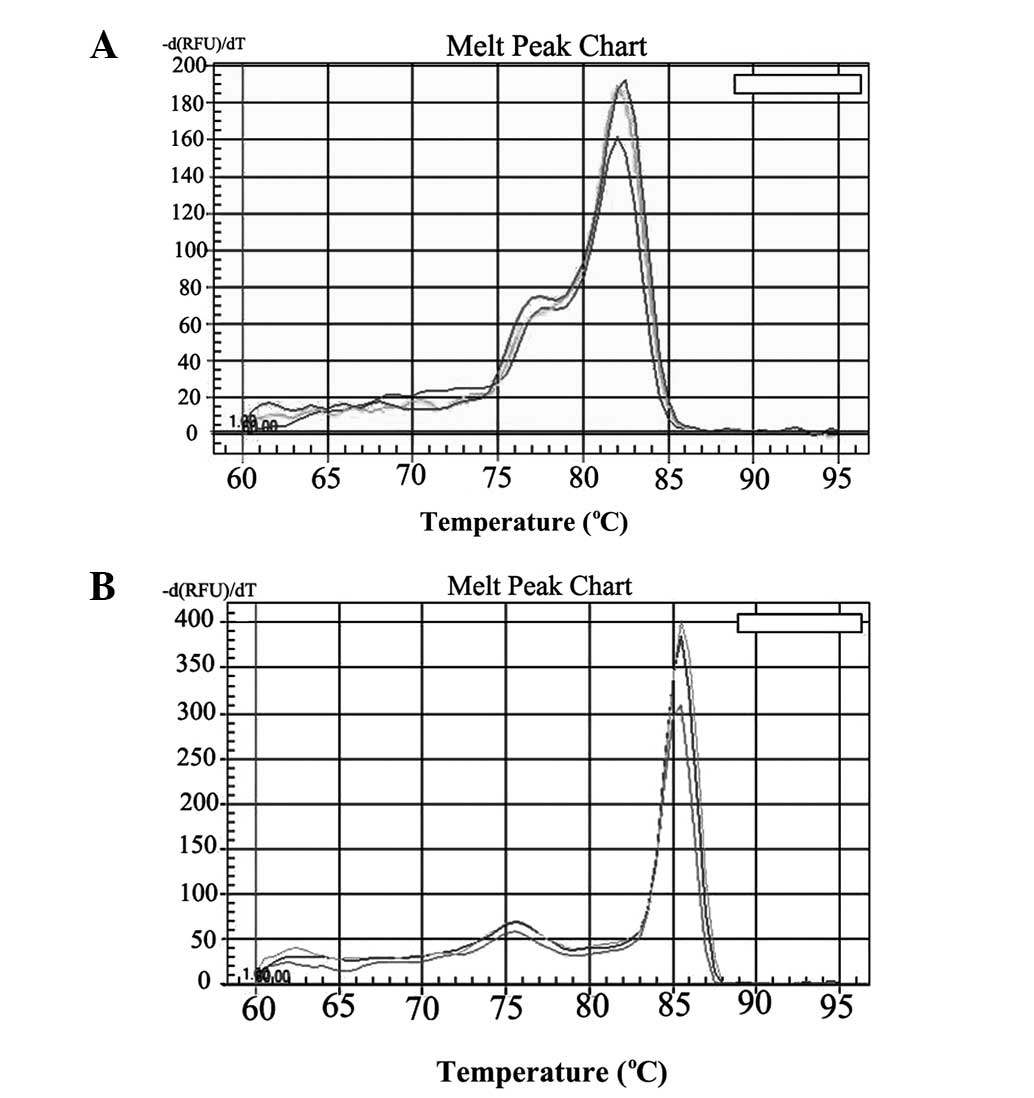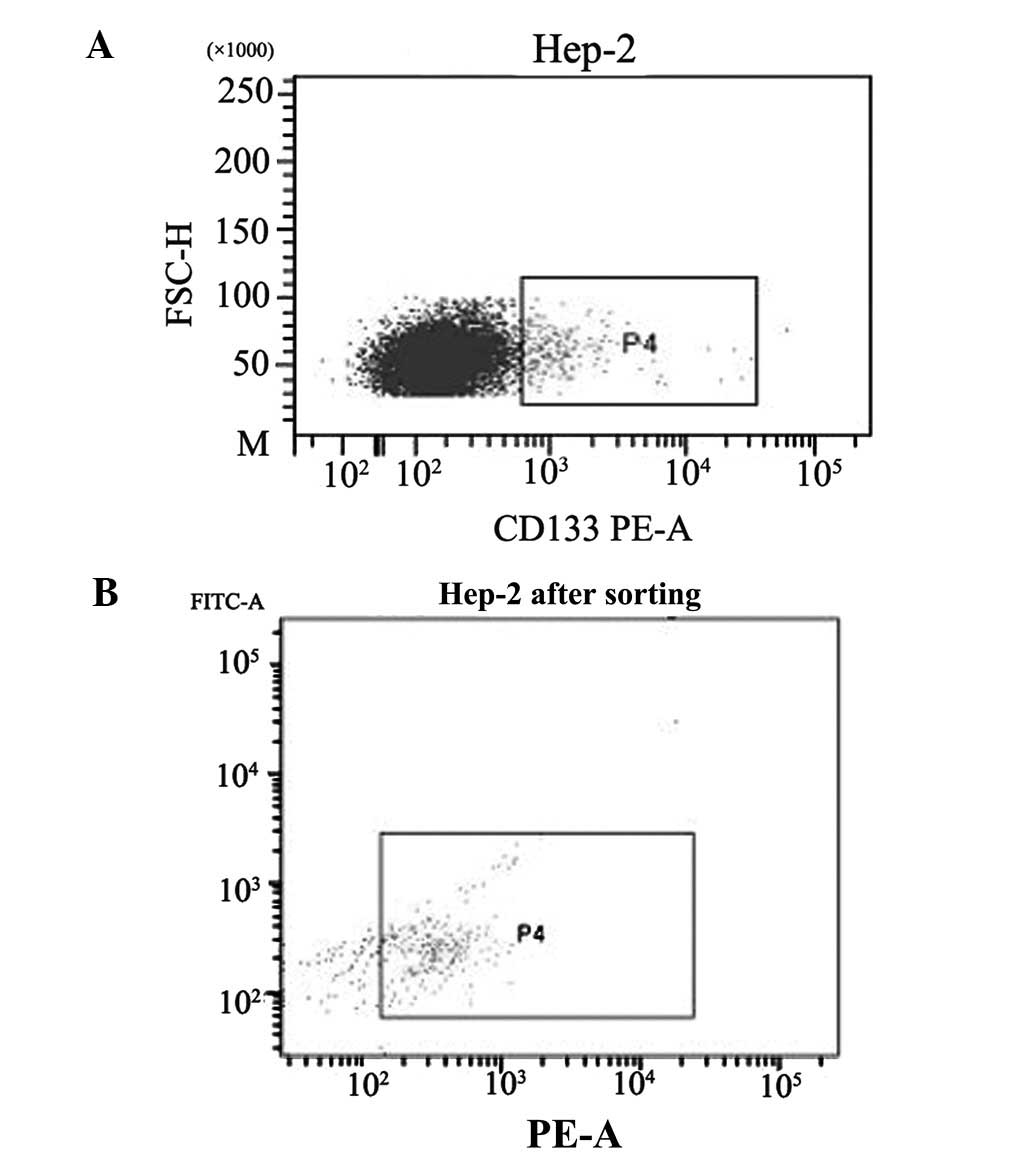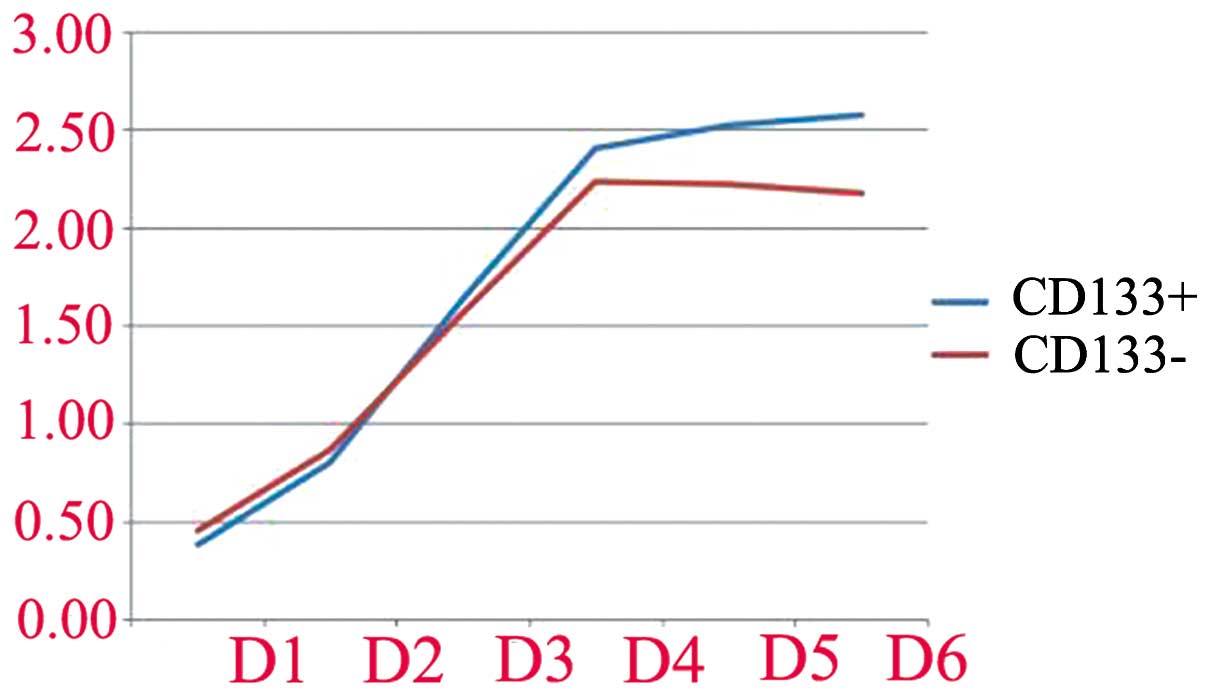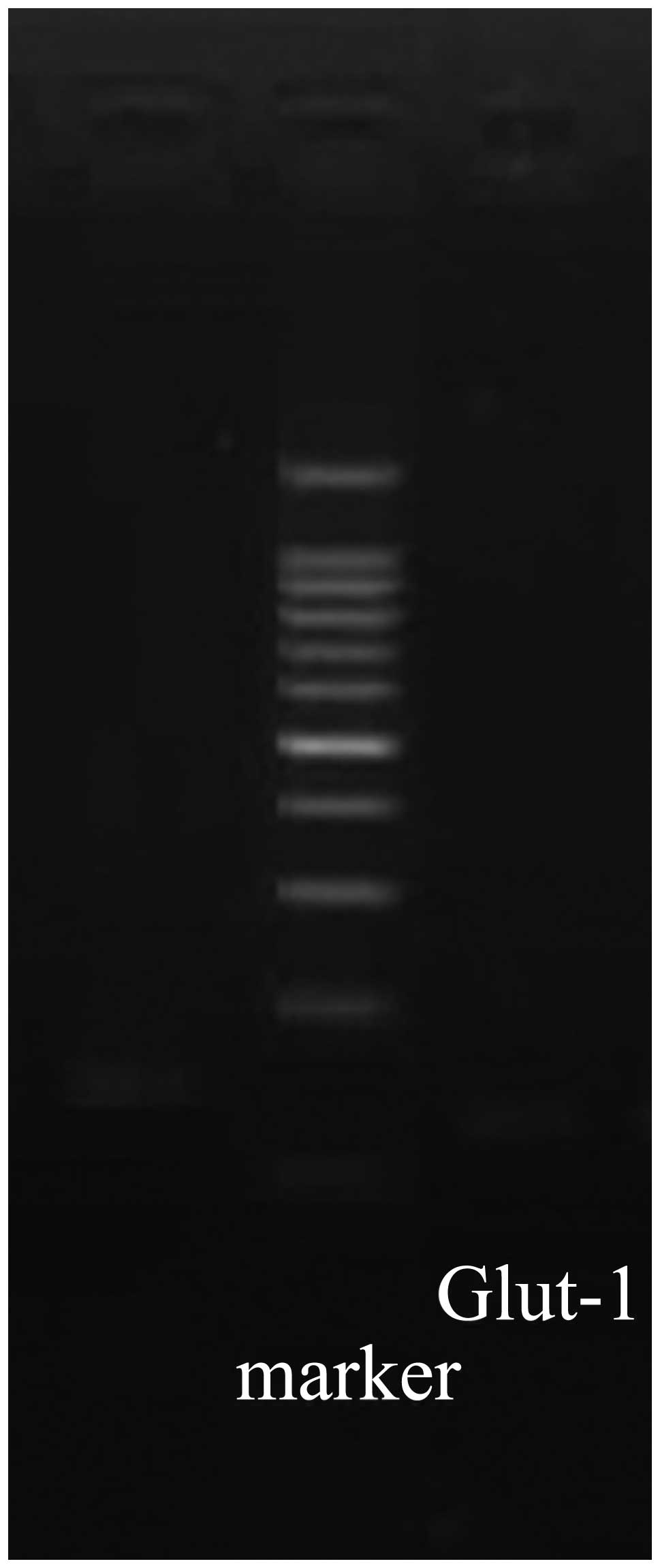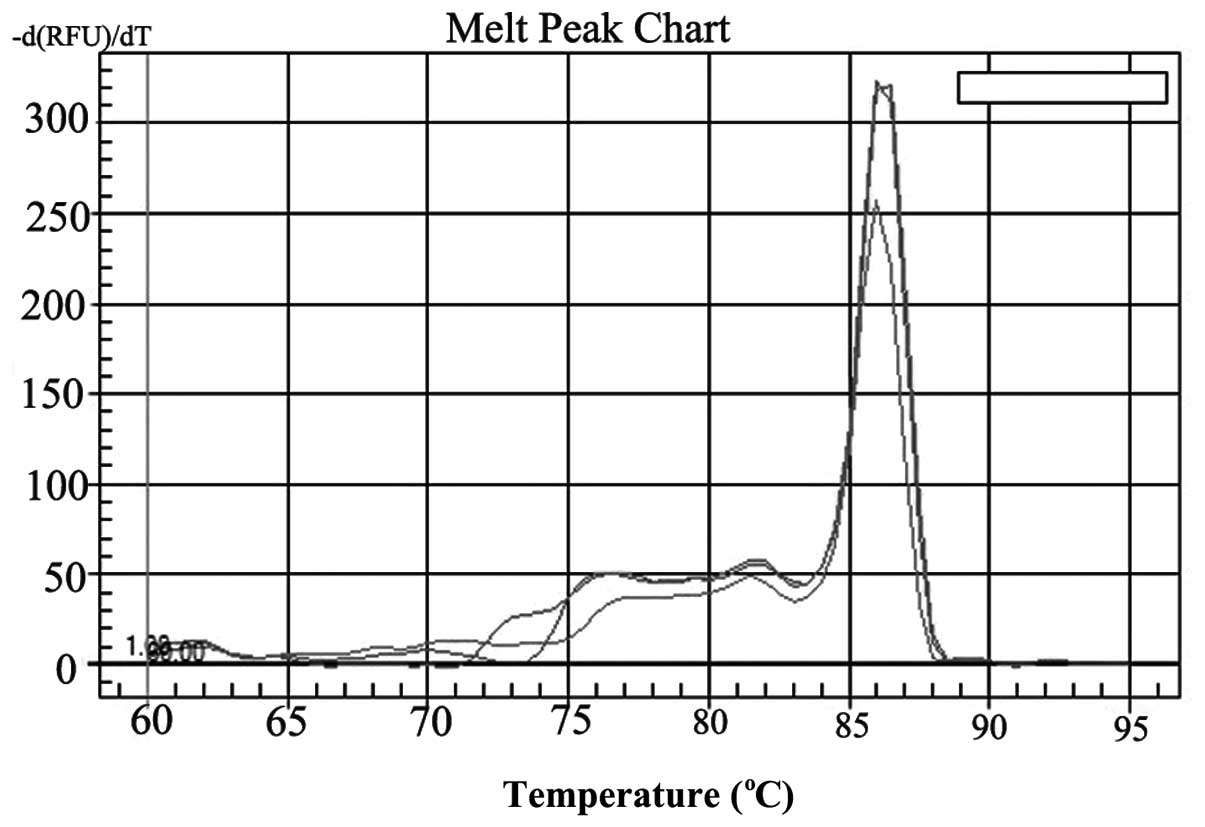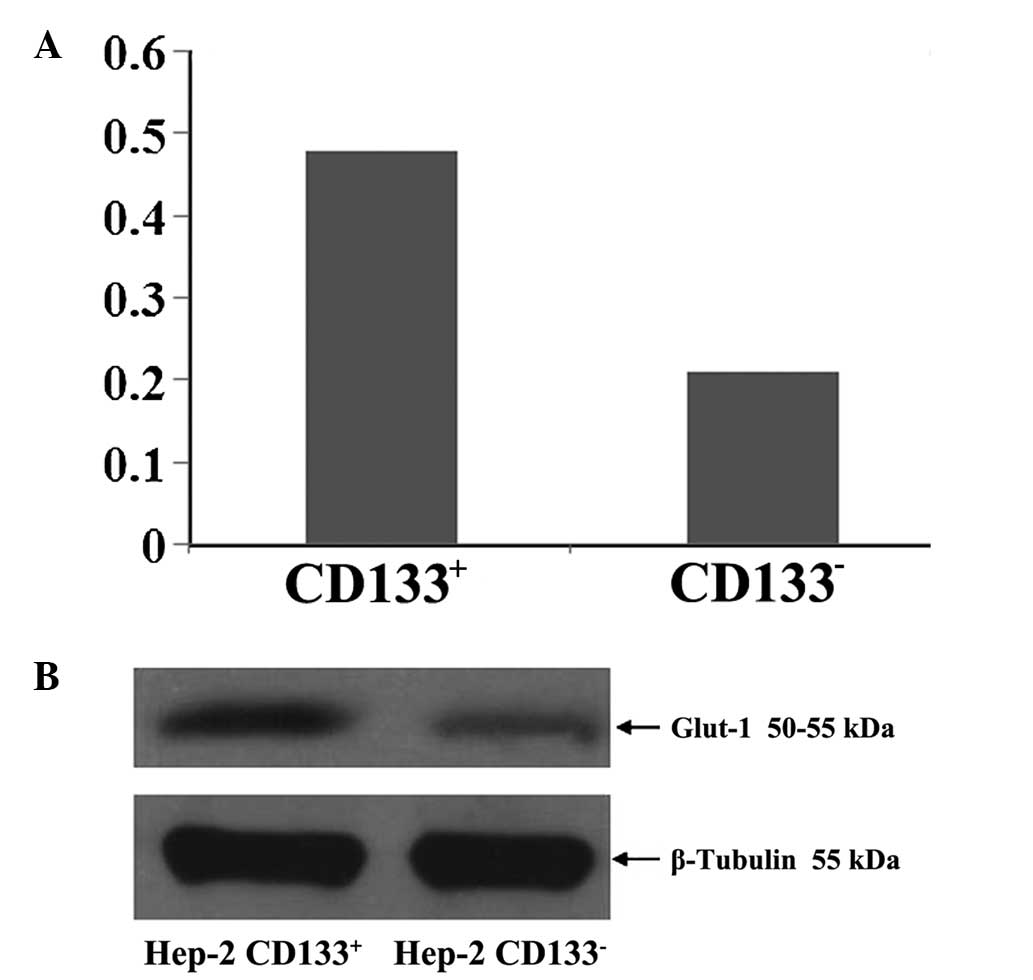Glucose transporter-1 expression in CD133+ laryngeal carcinoma Hep-2 cells
- Authors:
- Published online on: October 18, 2013 https://doi.org/10.3892/mmr.2013.1740
- Pages: 1695-1700
Abstract
Introduction
Cancer stem cells (CSCs) have been demonstrated to play a role in laryngeal carcinoma (1–4). CD133 is a useful putative marker for CSCs in human laryngeal tumors (1–4), as well as in other types of cancer (5–8). Numerous studies have demonstrated that CD133+ CSCs possess higher clonogenicity, invasiveness and tumorigenesis compared with CD133− cells (1–8). CD133+ cells are resistant to standard chemotherapy (1,8) and radiotherapy (5–7). However, whether CD133+ CSCs have distinct metabolic programs from the bulk of tumor cells is not well established. Certain regulatory pathways, including the Wnt (9), Notch (10), Hedgehog (11) and PI3K/Akt pathways (12), have been found to be important in governing cell metabolism and energy sensing of CSCs.
Interest in the Warburg effect has escalated in recent years due to the proven utility of FDG-PET for imaging tumors in cancer patients and may be useful in disease diagnosis, staging, restaging and therapy monitoring in numerous types of cancer (13,14), and cervical metastasis of carcinoma from an unknown primary tumor (14). The Warburg effect dictates that cancer cells rely on glycolysis rather than oxidative phosphorylation under aerobic conditions. In numerous cancer cells, glucose is used mainly for the glycolytic pathway (15). Stem cells have been demonstrated to express high levels of glycolytic enzymes and rely mostly on glycolysis to meet their energy demands (16). Glucose is transported through cell membranes by glucose transporters (Glut). Numerous studies (17–20), including ours (21,22), have revealed that Glut-1 is significant in malignant glucose metabolism and that it may contribute to the increased FDG uptake. However, studies of Glut-1 expression in CSCs are limited (6,23,24). In CD133+ thyroid cancer, infantile hemangioma and embryonal neoplasms of the central nervous system, Glut-1 exhibited a higher expression than in CD133− cells. Thus, the role of the Warburg effect and Glut-1 in CSCs requires further study.
In our previous studies, we revealed a high Glut-1 expression in laryngeal carcinoma (25–27). We also demonstrated that antisense Glut-1 may decrease glucose uptake and inhibit the proliferation of Hep-2 cells. In the present study, we investigated the proliferation of CD133+ Hep-2 cells and whether Glut-1 is expressed in laryngeal carcinoma CD133+ Hep-2 cells.
Materials and methods
Cell culture
The laryngeal carcinoma Hep-2 cell line was purchased from the Cell Research Institute of the Chinese Academy of Sciences (Shanghai, China). Hep-2 cells were cultured in Dulbecco’s modified Eagle’s medium (Gibco-BRL, Gaithersburg, MD, USA) containing 10% heat-inactivated fetal bovine serum (FBS; Hyclone, Logan, UT, USA), 2 mM L-glutamine, 100 U/ml penicillin and 100 g/ml streptomycin at 37°C in a 5% CO2 atmosphere. Cells were trypsinized and harvested after reaching 80–90% confluence. The study was approved by the Ethics Committee of he First Affiliated Hospital, College of Medicine, Zhejiang University.
Detection of CD133 expression in Hep-2 cells by real-time reverse transcription-polymerase chain reaction (RT-PCR)
Cells were homogenized in TRIzol reagent (Invitrogen, Carlsbad, CA, USA). Total RNA was extracted from cells according to the manufacturer’s instructions. The concentration of total RNA was measured by ultraviolet spectrophotometry; an optical density (OD) 260/280 ratio between 1.8 and 2.0 was deemed to be acceptably pure. Reverse transcription was performed according to the manufacturer’s instructions. Briefly, l μg of total RNA and the Moloney Murine Leukemia Virus (MMLV) reverse transcriptase (Fermentas, Burlington, Canada) in a 20 μl reaction volume consisting of 0.5 μg/μl of oligo d(T) primer, 1 μl of random primers (0.2 μg/μl) and 10 μl of DEPC-H2O. The reaction mix was first pre-denatured at 65°C for 10 min. Following the addition of 200 U M-MLV reverse transcriptase (Fermentas), the samples were incubated at 42°C for 1 h and annealed at 70°C for 10 min. The synthesized cDNA was used as a template for real-time fluorescent quantitative PCR using the fluorescent dye SYBR Green and the Eppendorf Realplex 4 real-time PCR system (Eppendorf, Hamburg, Germany). The 20 μl reaction mixture consisted of 10 μl of 2X SYBR Green, 1 μl of template, 1 μl of upstream and downstream specific primers and 8 μl of deionized water. The reaction mixture was pre-denatured at 95°C for 2 min, followed by 40 cycles at 95°C for 15 sec, 59°C for 20 sec and 72°C for 20 sec. Each primer sample was run in triplicate. The primers used were as follows: CD133-forward (F): CACTTACGGCACTCTTCACCTG; CD133-reverse (R): CCAGTCTGAGCCAAGTAGCTGTC. Glyceraldehyde 3-phosphate dehydrogenase (GAPDH) was used as an internal standard for data calibration (GAPDH-F: GGGTGTGAACCATGAGAAGTATG; GAPDH-R: GATGGCATGGACTGTGGTCAT). The lengths of the PCR products were 213 (CD133) and 145 bp (GAPDH).
To distinguish between specific and non-specific products and primer dimers, dissociation curve analysis was conducted immediately following amplification by continuous monitoring of the SYBR Green I fluorescence signal at temperatures between 60 and 95°C. For calculation of differential gene expression, the 2−ΔΔCt formula was used.
Flow cytometry (FCM) and fluorescence-activated cell sorting (FACS)
Cultured cells were trypsinized using 0.25% trypsin and rinsed in phosphate-buffered saline (PBS). The cells were centrifuged at 800 × g for 5 min and resuspended in up to 500 μl PBS. Cell suspensions were incubated with phycoerythrin (PE)-conjugated CD133 antibody in the dark for 30 min at room temperature. During the reaction, vortexing was performed for 5 min. Following the reaction, the cells were rinsed with PBS and resuspended in up to 400 μl PBS. Flow analysis was performed using a FACS instrument (Becton-Dickinson, Mountain View, CA, USA). CD133+ and CD133− cells were sorted. CD133-sorted cell populations were again suspended in serum-free medium (SFM; Sigma-Aldrich, St. Louis, MO, USA). The purities of sorted CD133+ and CD133− cells were evaluated by FCM.
Proliferation assays of CD133+ Hep-2 cells using the cell counting kit-8 (CCK-8) system
Cultured CD133+ and CD133− Hep-2 cells were trypsinized using 0.25% trypsin. Cell proliferation was measured using the CCK-8 system (Beyotime, Nanjing, Jiangsu, China), according to the manufacturer’s instructions. Briefly, 5×103 CD133+ or CD133− Hep-2 cells were seeded into 96-well culture plates. Cells were cultured in SFM at 37°C. Following 1–6 days, 10 μl of CCK-8 reagent was added to each well and following 2 h of incubation at 37°C, the absorbance was measured at 450 nm, using the following formula: OD = ODcell-ODblank.
Expression of Glut-1 mRNA in CD133+ and CD133− Hep-2 cells by real-time RT-PCR
Real-time RT-PCR was performed as described previously. Briefly, CD133+ and CD133− Hep-2 cells were homogenized in TRIzol reagent (Invitrogen). Total RNA was extracted from cells according to the manufacturer’s instructions. Using l μg of total RNA and MMLV in a 20 μl reaction volume, the reaction mix was first pre-denatured at 65°C for 10 min. Following the addition of 200 U MMLV, the samples were incubated at 42°C for 1 h and annealed at 70°C for 10 min. The synthesized cDNA was used as a template for real-time fluorescent quantitative PCR. The 20 μl reaction mixture consisted of 10 μl of 2X SYBR Green, 1 μl of template, 1 μl of upstream and downstream specific primers and 8 μl of deionized water. The reaction mixture was pre-denatured at 95°C for 2 min, followed by 40 cycles at 95°C for 15 sec, 59°C for 20 sec and 72°C for 20 sec. Experiments were performed in triplicate and were repeated at least twice independently. The primers used were as follows: Glut-1-forward (F): CCGCAACGAGGAGAACCG; Glut-1-reverse: GTGACCTTCTTCTCCCGCATC. GAPDH was used as an internal standard for data calibration (GAPDH-F: GGGTGTGAACCATGAGAAGTATG; GAPDH-R: GATGGCATGGACTGTGGTCAT). Dissociation curve analysis was conducted. For calculation of differential gene expression, the 2−ΔΔ Ct formula was used.
Glut-1 protein levels in CD133+ and CD133− Hep-2 cells by western blotting
Western blotting was performed as described previously (26). The Glut-1 and β-tubulin (as a control) protein in each group of Hep-2 cells were assayed using a BAC protein quantitative kit (Wuhan Boster Biological Technology Co. Ltd., Wuhan, Hubei, China). Briefly, 80 μg of protein was subjected to 10% sodium dodecyl sulfate-polyacrylamide gel electrophoresis (SDS-PAGE) and transferred onto a nitrocellulose membrane (Millipore, Billerica, MA, USA). Skimmed milk (2%) was used as a blocking solution (room temperature, 1 h). The membrane was incubated with the primary antibody (Glut-1, 1:1,000; β-tubulin, 1:5,000) at room temperature for 3 h and with the secondary antibody (1:5,000, donkey anti-rabbit; 1:2,000, donkey anti-mouse) at room temperature for 1 h. The proteins were detected using an enhanced chemiluminescence system (Santa Cruz Biotechnology, Inc., Santa Cruz, CA, USA) and were exposed to X-ray film. Protein expression was analyzed semi-quantitatively using the Kodak Gel Logic Analysis System (Carestream Health Inc., Rochester, NY, USA).
Statistical analysis
Statistical analyses were performed using SPSS for Windows, version 19.0. P<0.05 was considered to indicate a statistically significant difference.
Results
Expression of CD133 in the Hep-2 cell line
Real-time RT-PCR demonstrated that the sizes of the CD133 and GAPDH PCR product were 213 and 145 bp, respectively (Fig. 1). Dissociation curve analysis performed between 60–95°C demonstrated only the expected peaks at 82.1 and 85.1°C for CD133 and GAPDH, respectively (Fig. 2). The analysis demonstrated that each primer pair had sufficient specificity for use in the present study of CD133 expression. The mean ΔCt of CD133 expression was 10.98.
Detection of CD133+ Hep-2 cells by FCM
CD133 cells were isolated from the Hep-2 cell line using FCM. To evaluate the efficiency of FCM, harvested cells were subjected to FACS analysis. Prior to isolation, the CD133+ fraction was 1.2%, which increased to 76.1% following isolation (Fig. 3). Successive tests also proved that cells grew well following isolation.
Proliferation of CD133+ Hep-2 cells
Following isolation, CD133+ and CD133− cells were cultured separately in SFM. Proliferation is displayed in Table I and Fig. 4. The proliferation of CD133+ and CD133− cells was not different during the first 3 days (P>0.05). From day 4, however, the proliferation capacity of CD133+ cells in vitro was higher than that of CD133− cells (P<0.05).
Table IUltraviolet absorption of CD133+ cells and CD133− cells on days 1, 2, 3, 4, 5 and 6 (mean ± SD). |
Glut-1 mRNA levels in CD133+ and CD133− Hep-2 cells
Real-time RT-PCR demonstrated that the sizes of the Glut-1 and GAPDH PCR products were 123 and 145 bp, respectively (Fig. 5). Dissociation curve analysis performed between 60–95°C demonstrated only the expected peaks at 86.2 and 85.1°C for Glut-1 and GAPDH mRNA, respectively (Fig. 6). Thus, the analysis demonstrated that each primer pair had sufficient specificity for use in the present study of Glut-1 mRNA expression. The mean ΔCt of Glut-1 mRNA expression in CD133+ cells was 1.78. The mean ΔCt of Glut-1 mRNA expression in CD133− cells was 1.00. The expression of Glut-1 mRNA differed significantly between CD133+ and CD133− cells (P<0.05).
Glut-1 protein levels in CD133+ and CD133− Hep-2 cells
Mean Glut-1 protein levels in CD133+ Hep-2 cells and CD133− Hep-2 cells relative to β-tubulin were 0.48 ± 0.02 and 0.21 ± 0.03 μg/μl, respectively (P<0.05; Fig. 7).
Discussion
Glut-1 is highly expressed in numerous types of cancer, including laryngeal carcinoma (21,25) and is associated with resistance to chemoradiotherapy and poor prognosis (28–30). High expression of Glut-1 has been demonstrated to be associated with FDG uptake (17–20,22). Thus, Glut-1 is an intrinsic marker of hypoxia in cancer (31,32). However, studies of Glut-1 expression in CSCs are limited (6,23,24). To the best of our knowledge, no study of Glut-1 expression in laryngeal CSCs exists.
CD133 has been demonstrated to be a marker of CSCs in laryngeal carcinoma (1–4). In the present study, we successively isolated CD133+ Hep-2 laryngeal carcinoma cells by FCM. Prior to isolation, we confirmed the expression of CD133 in the Hep-2 cells by real-time RT-PCR. Subsequently, FCM demonstrated that the proportion of CD133+ Hep-2 cells was only 1.2%. Following isolation, the approximate proportion of CD133+ Hep-2 cells was 76.1%. In 2007, Zhou et al first demonstrated that CD133 was a marker of CSCs in a Hep-2 laryngeal cell line (4). They demonstrated that the CD133+ fraction was 2.45% by FACS analysis prior to isolation and this was increased to 91.26% following isolation. Wei et al demonstrated that the CD133+ fraction was 3.15% by FACS analysis prior to isolation, which increased to 90.26% following isolation (3). They demonstrated that CD133+ cells have a stronger ability to form tumors in vivo than unsorted cells. In the present study, we also demonstrated that the proliferation capacity of CD133+ cells in vitro was higher than that of CD133− cells at days 4, 5 and 6 (P<0.05). Thus, our study demonstrated that CD133 may be a marker of laryngeal carcinoma CSCs. However, further in vivo experiments are required to determine whether the CD133+ cells are comparable with the in vitro phenotype.
Whether CD133+ CSCs have metabolic programs distinct from those of the bulk of tumor cells is not well established. Certain regulatory pathways, including the Wnt (9), Notch (10), Hedgehog (11) and PI3K/Akt pathways (12), have been demonstrated to be important in the regulation of CSC metabolism and energy sensing. However, in laryngeal carcinoma, Chen et al demonstrated no significant difference between the expression of Notch2 and PTEN in CD133+ and CD133− cells, although they were expressed at high levels in CD133+ cells (2). Thus, other metabolic pathways may play a regulatory role in CSCs of laryngeal carcinoma, including the Warburg effect. Ke et al demonstrated that Glut-1 expression was higher in CD133+ than CD133− cells in thyroid cancer following 131I radiotherapy (6). Mai et al demonstrated that stem cells from proliferating hemangiomas may produce Glut-1 (23). The present study is to the best of our knowledge the first to demonstrate that Glut-1 expression in laryngeal CSCs and Glut-1 mRNA and protein expression were higher in CD133+ than in CD133− cells (P<0.05). These results suggest that Glut-1 expression may play a role in the CSCs of laryngeal carcinoma. Glut-1 is a transmembrane protein and a main glucose transporter. CSCs rely primarily on glycolysis to meet their energy demands (16), which is dependent on glucose uptake. Thus, we also suggest that Glut-1 is important in the energy supply of laryngeal CD133+ Hep-2 cells. Several studies have demonstrated that the inhibition of Glut-1 expression may repress glycolysis and glucose uptake in cancer cells (27,33). Phloretin is a glucose transporter inhibitor stated to induce apoptosis and overcome drug resistance under hypoxic conditions (33). In laryngeal carcinoma, we demonstrated that antisense Glut-1 may decrease glucose uptake and inhibit the proliferation of Hep-2 cells (27). We suggested that Glut-1 may be a therapeutic target in laryngeal carcinoma. However, this requires further study.
In conclusion, our data do not permit a definitive conclusion regarding the expression of Glut-1 in laryngeal CSCs. However, our findings demonstrate that Glut-1 mRNA and protein expression is higher in CD133+ than in CD133− cells. Thus, Glut-1 may be important in the energy supply of laryngeal CD133+ Hep-2 cells and may represent a potential therapeutic target for the inhibition of the proliferation of laryngeal CSCs.
Acknowledgements
This study was supported by the National Natural Science Foundation of China (no. 81172562 and 81372903), Science and Technology Department of Zhejiang Province, China (no. 2009C33026), Health Department of Zhejiang Province (no. 2010KYA062 and no. 2009B042) and Department of Education of Zhejiang Province, China (no. Y201121184).
References
|
Yang JP, Liu Y, Zhong W, Yu D, Wen LJ and Jin CS: Chemoresistance of CD133+ cancer stem cells in laryngeal carcinoma. Chin Med J (Engl). 124:1055–1060. 2011.PubMed/NCBI | |
|
Chen H, Zhou L, Dou T, Wan G, Tang H and Tian J: BMI1’S maintenance of the proliferative capacity of laryngeal cancer stem cells. Head Neck. 33:1115–1125. 2011. | |
|
Wei XD, Zhou L, Cheng L, Tian J, Jiang JJ and Maccallum J: In vivo investigation of CD133 as a putative marker of cancer stem cells in Hep-2 cell line. Head Neck. 31:94–101. 2009. View Article : Google Scholar : PubMed/NCBI | |
|
Zhou L, Wei X, Cheng L, Tian J and Jiang JJ: CD133, one of the markers of cancer stem cells in Hep-2 cell line. Laryngoscope. 117:455–460. 2007. View Article : Google Scholar : PubMed/NCBI | |
|
Piao LS, Hur W, Kim TK, et al: CD133+ liver cancer stem cells modulate radioresistance in human hepatocellular carcinoma. Cancer Lett. 315:129–137. 2012. | |
|
Ke CC, Liu RS, Yang AH, et al: CD133-expressing thyroid cancer cells are undifferentiated, radioresistant and survive radioiodide therapy. Eur J Nucl Med Mol Imaging. 40:61–71. 2013. View Article : Google Scholar : PubMed/NCBI | |
|
Bao S, Wu Q, McLendon RE, et al: Glioma stem cells promote radioresistance by preferential activation of the DNA damage response. Nature. 444:756–760. 2006. View Article : Google Scholar : PubMed/NCBI | |
|
Liu YP, Yang CJ, Huang MS, et al: Cisplatin selects for multidrug-resistant CD133+ cells in lung adenocarcinoma by activating Notch signaling. Cancer Res. 73:406–416. 2013. View Article : Google Scholar : PubMed/NCBI | |
|
Neth P, Ries C, Karow M, Egea V, Ilmer M and Jochum M: The Wnt signal transduction pathway in stem cells and cancer cells: influence on cellular invasion. Stem Cell Rev. 3:18–29. 2007. View Article : Google Scholar : PubMed/NCBI | |
|
Huang D, Gao Q, Guo L, et al: Isolation and identification of cancer stem-like cells in esophageal carcinoma cell lines. Stem Cells Dev. 18:465–473. 2009. View Article : Google Scholar : PubMed/NCBI | |
|
Gangopadhyay S, Nandy A, Hor P and Mukhopadhyay A: Breast cancer stem cells: a novel therapeutic target. Clin Breast Cancer. 13:7–15. 2013. View Article : Google Scholar | |
|
Ping YF, Yao XH, Jiang JY, et al: The chemokine CXCL12 and its receptor CXCR4 promote glioma stem cell-mediated VEGF production and tumour angiogenesis via PI3K/AKT signalling. J Pathol. 224:344–354. 2011. View Article : Google Scholar : PubMed/NCBI | |
|
Bensinger SJ and Christofk HR: New aspects of the Warburg effect in cancer cell biology. Semin Cell Dev Biol. 23:352–361. 2012. View Article : Google Scholar : PubMed/NCBI | |
|
Zhao K, Luo XM, Zhou SH, et al: 18F-fluorodeoxyglucose positron emission tomography/computed tomography as an effective diagnostic workup in cervical metastasis of carcinoma from an unknown primary tumor. Cancer Biother Radiopharm. 27:685–693. 2012. View Article : Google Scholar | |
|
Hammoudi N, Ahmed KB, Garcia-Prieto C and Huang P: Metabolic alterations in cancer cells and therapeutic implications. Chin J Cancer. 30:508–525. 2011. View Article : Google Scholar : PubMed/NCBI | |
|
Varum S, Rodrigues AS, Moura MB, et al: Energy metabolism in human pluripotent stem cells and their differentiated counterparts. PLoS One. 6:e209142011. View Article : Google Scholar : PubMed/NCBI | |
|
Han MW, Lee HJ, Cho KJ, et al: Role of FDG-PET as a biological marker for predicting the hypoxic status of tongue cancer. Head Neck. 34:1395–1402. 2012. View Article : Google Scholar : PubMed/NCBI | |
|
Li XF, Ma Y, Sun X, Humm JL, Ling CC and O’Donoghue JA: High 18F-FDG uptake in microscopic peritoneal tumors requires physiologic hypoxia. J Nucl Med. 51:632–638. 2010. View Article : Google Scholar : PubMed/NCBI | |
|
Alakus H, Batur M, Schmidt M, et al: Variable 18F-fluorodeoxyglucose uptake in gastric cancer is associated with different levels of GLUT-1 expression. Nucl Med Commun. 31:532–538. 2010.PubMed/NCBI | |
|
Nagamatsu A, Umesaki N, Li L and Tanaka T: Use of 18F-fluorodeoxyglucose positron emission tomography for diagnosis of uterine sarcomas. Oncol Rep. 23:1069–1076. 2010.PubMed/NCBI | |
|
Zhou S, Wang S, Wu Q, Fan J and Wang Q: Expression of glucose transporter-1 and -3 in the head and neck carcinoma--the correlation of the expression with the biological behaviors. ORL J Otorhinolaryngol Relat Spec. 70:189–194. 2008. View Article : Google Scholar : PubMed/NCBI | |
|
Li LF, Zhou SH, Zhao K, et al: Clinical significance of FDG single-photon emission computed tomography: Computed tomography in the diagnosis of head and neck cancers and study of its mechanism. Cancer Biother Radiopharm. 23:701–714. 2008. View Article : Google Scholar : PubMed/NCBI | |
|
Mai HM, Zheng JW, Wang YA, et al: CD133 selected stem cells from proliferating infantile hemangioma and establishment of an in vivo mice model of hemangioma. Chin Med J (Engl). 126:88–94. 2013.PubMed/NCBI | |
|
Loda M, Xu X, Pession A, Vortmeyer A and Giangaspero F: Membranous expression of glucose transporter-1 protein (GLUT-1) in embryonal neoplasms of the central nervous system. Neuropathol Appl Neurobiol. 26:91–97. 2000. View Article : Google Scholar : PubMed/NCBI | |
|
Wu XH, Chen SP, Mao JY, Ji XX, Yao HT and Zhou SH: Expression and significance of hypoxia-inducible factor-1α and glucose transporter-1 in laryngeal carcinoma. Oncol Lett. 5:261–266. 2013. | |
|
Xu YY, Bao YY, Zhou SH and Fan J: Effect on the expression of MMP-2, MT-MMP in laryngeal carcinoma Hep-2 cell line by antisense glucose transporter-1. Arch Med Res. 43:395–401. 2012. View Article : Google Scholar : PubMed/NCBI | |
|
Zhou SH, Fan J, Chen XM, Cheng KJ and Wang SQ: Inhibition of cell proliferation and glucose uptake in human laryngeal carcinoma cells by antisense oligonucleotides against glucose transporter-1. Head Neck. 31:1624–1633. 2009. View Article : Google Scholar : PubMed/NCBI | |
|
Korkeila E, Jaakkola PM, Syrjänen K, Pyrhönen S and Sundström J: Pronounced tumour regression after radiotherapy is associated with negative/weak glucose transporter-1 expression in rectal cancer. Anticancer Res. 31:311–315. 2011.PubMed/NCBI | |
|
Chiba I, Ogawa K, Morioka T, et al: Clinical significance of GLUT-1 expression in patients with esophageal cancer treated with concurrent chemoradiotherapy. Oncol Lett. 2:21–28. 2011.PubMed/NCBI | |
|
Kunkel M, Moergel M, Stockinger M, et al: Overexpression of GLUT-1 is associated with resistance to radiotherapy and adverse prognosis in squamous cell carcinoma of the oral cavity. Oral Oncol. 43:796–803. 2007. View Article : Google Scholar : PubMed/NCBI | |
|
Eckert AW, Kappler M, Schubert J and Taubert H: Correlation of expression of hypoxia-related proteins with prognosis in oral squamous cell carcinoma patients. Oral Maxillofac Surg. 16:189–196. 2012. View Article : Google Scholar : PubMed/NCBI | |
|
Rademakers SE, Lok J, van der Kogel AJ, Bussink J and Kaanders JH: Metabolic markers in relation to hypoxia; staining patterns and colocalization of pimonidazole, HIF-1α, CAIX, LDH-5, GLUT-1, MCT1 and MCT4. BMC Cancer. 11:1672011.PubMed/NCBI | |
|
Cao X, Fang L, Gibbs S, et al: Glucose uptake inhibitor sensitizes cancer cells to daunorubicin and overcomes drug resistance in hypoxia. Cancer Chemother Pharmacol. 59:495–505. 2007. View Article : Google Scholar : PubMed/NCBI |



